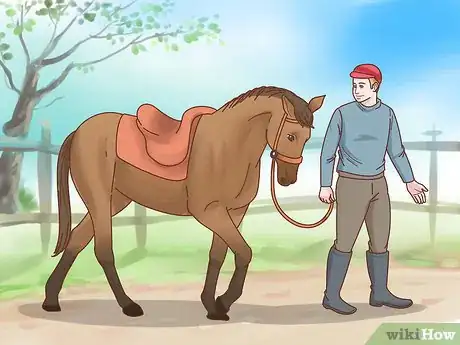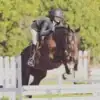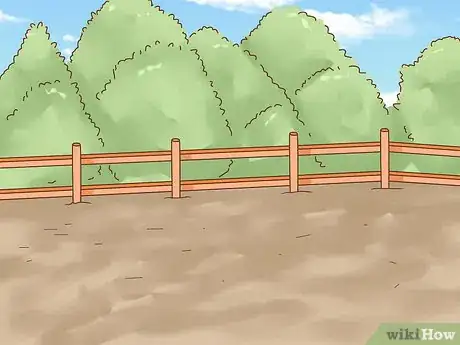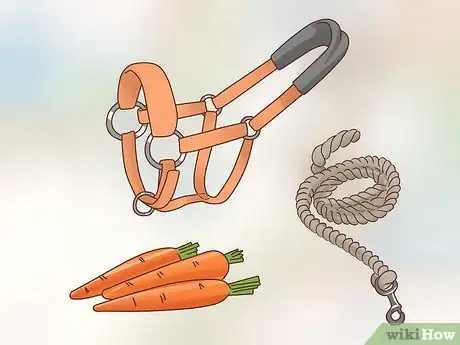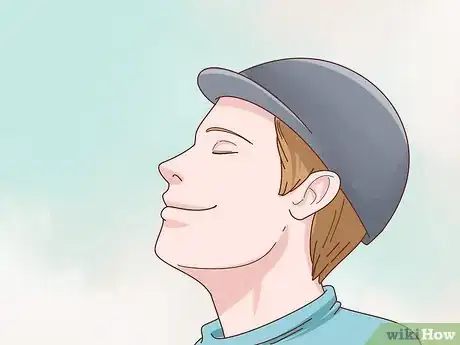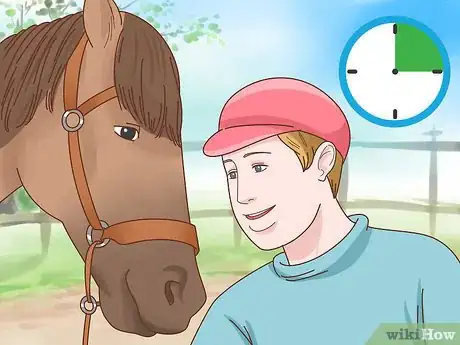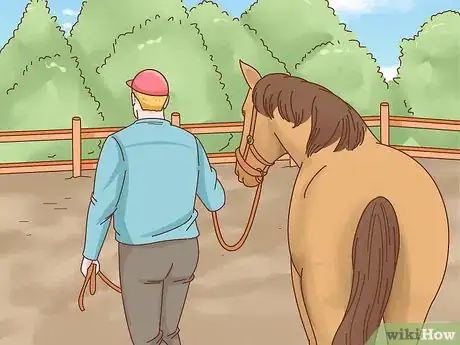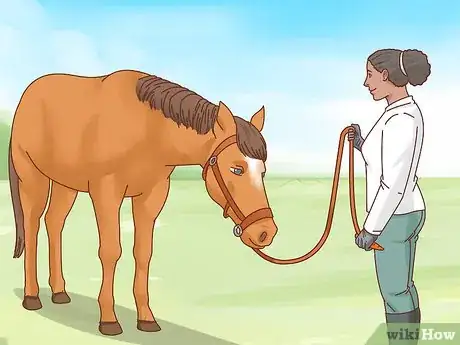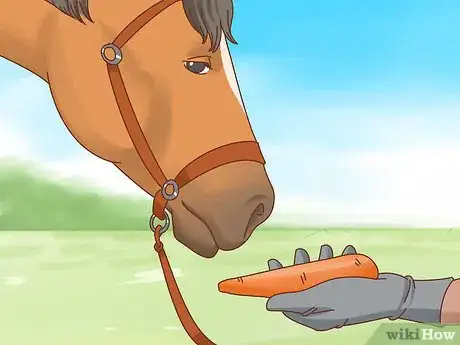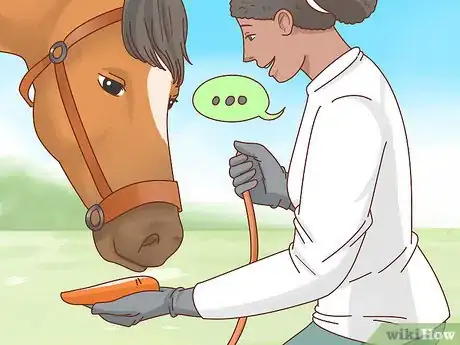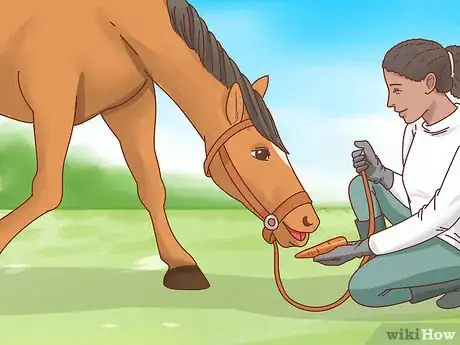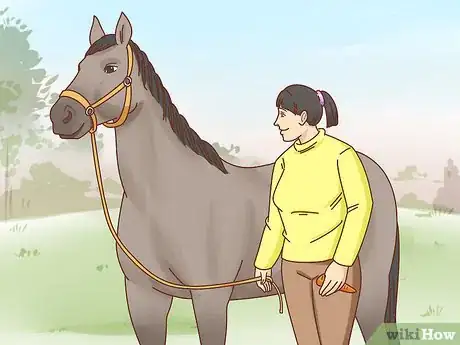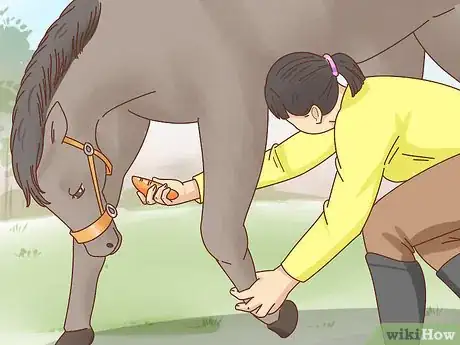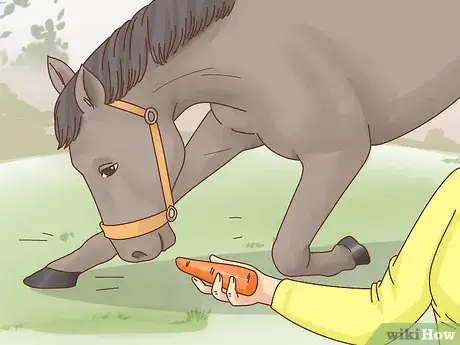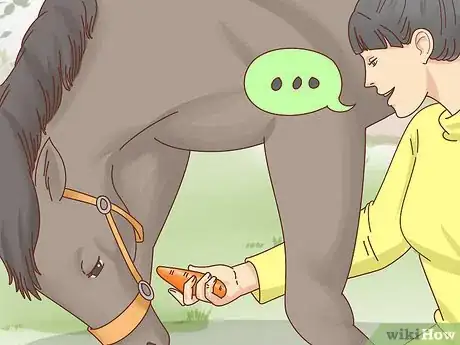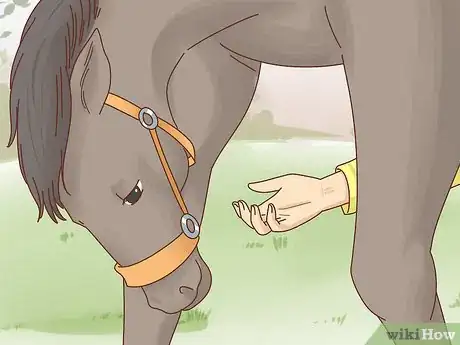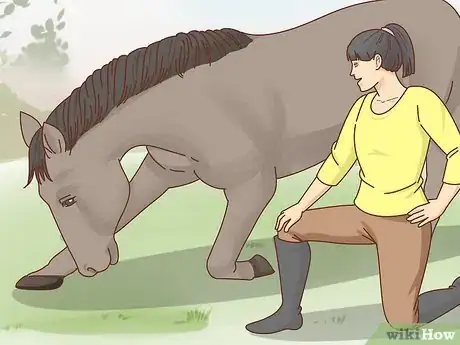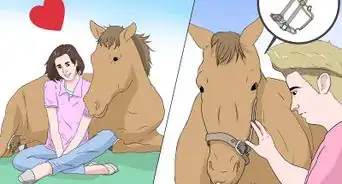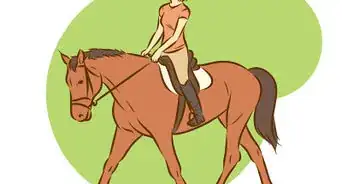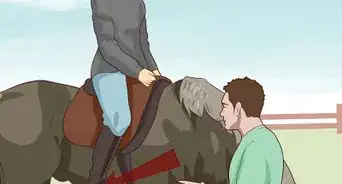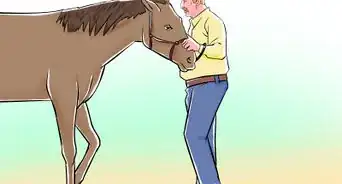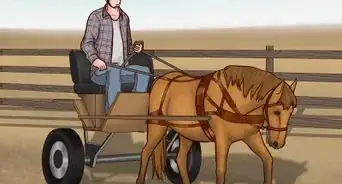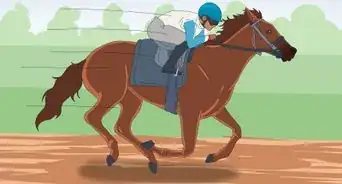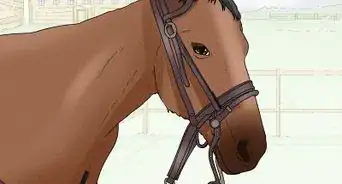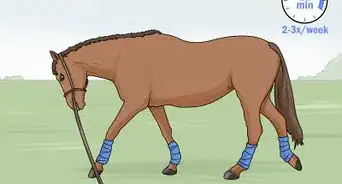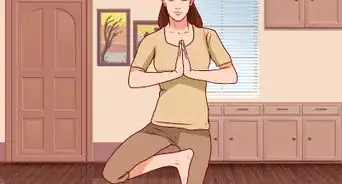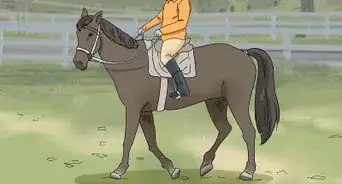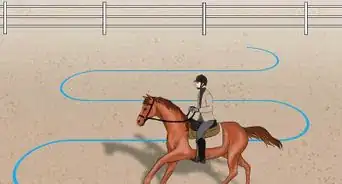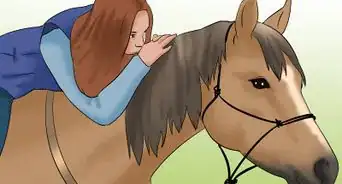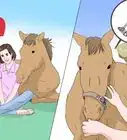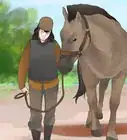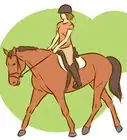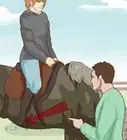This article was co-authored by Kate Jutagir. Kate Jutagir is an Equestrian Specialist, Hunter/Jumper Trainer, and the Owner of Blackhound Equestrian, a premier training barn located on 65 acres in Castro Valley, California. Originally designed to be a riding school used as a springboard for dedicated students into careers in the sport, Blackhound Equestrian has grown into a hunter/jumper training program for all levels focusing on providing a solid foundation needed for personal advancement in the sport. Kate has over 25 years of equestrian instruction and training experience. Her focus on developing horse and rider partnerships provides a complete equestrian education for both beginners and advanced riders alike.
This article has been viewed 132,865 times.
A horse bows by kneeling on one leg, extending the other leg in front of it, and lowering its head to the ground. This is a relatively easy trick to teach, requiring little in terms of equipment or expertise. After preparing supplies and a suitable practice space, you should use treats to encourage the horse to first bow its head, then kneel to the ground. You can then begin removing treats from the exercise, teaching the horse to perform the trick on command.
Steps
Ensuring Your Horse is Ready to Train
-
1Evaluate your horse's personality. You should already be familiar with the temperament and personality of the horse you are trying to train, and the horse should already be able to stand still on command. Horses differ drastically in their level of energy, attention and patience, just like people. Take some time to practice simple obedience exercises with your horse, such as walking on a lead rope, or gentle riding in a safe environment.[1]
-
2Choose a good location to train your horse. The ground should be relatively soft and comfortable. Otherwise, your horse may not wish to put their knees down on the ground. Soft grass or relatively rock-free dirt is a good choice. Also make sure the area is calm and quiet, and clear of distracting or noisy objects like running machinery. This will ensure that your horse is comfortable, and can pay full attention to your instruction.[2]Advertisement
-
3Gather supplies. You will need a lead rope and halter that fits your horse, as well as carrots, apples or another horse treat to use as a reward during the process. You should also wear leather gloves and boots for safety. Make sure to show your horse your equipment, allowing them to touch, taste, and feel them before you begin training so that they do not become frightened by them.[3]
-
4Adopt a patient and positive attitude. Horses are very sensitive to noise and emotion, and if you become impatient or try to work too quickly they may become resistant or even frightened. Throughout the process, speak soothingly to your horse, offering reassurance and praise. If you are not comfortable around large animals, take some time to practice simply interacting with your horse until you are at ease.[4]
-
5Limit training sessions to 5-15 minutes each. While all horses are different, any horse will become frustrated and lose interest if you try to teach them too much in a single session. Limiting the length of each session will ensure that you don't stress your horse out, causing them to resist the training and potentially hurting your progress.[5]
-
6Lead your horse into the training area. You may wish to walk them around, guiding them with their lead rope, until they have had a chance to familiarize themselves with the environment. Once they are calm and attentive, listening to you and responding to your voice and gestures, you may begin training.
Teaching Your Horse to Reach Down
-
1Stand in front of the horse. Hold the horse's lead rope loosely but securely in one hand. Leave the other hand free to stroke the horse, and to grab treats. You should keep the treats in a pocket well out of reach of the horse, so that it won't be tempted to reach and grab them.[6]
- Remember to always retain control of the horse's treats, only allowing the horse to eat one when it does what you want. If the horse figures out it can get the treats from you without doing what you want, it may be very difficult to train.
-
2Offer a treat below the horse's nose. The idea is to encourage your horse to lower its head as far as it is willing to. Move the treat down, towards its feet, until it is reluctant to lower it further, then praise the horse and allow it to eat the treat. This will teach the horse to associate lowering its nose at your command with receiving treats.[7]
- If the horse does not seem to understand, you can encourage it to lower its head with a light, constant tug downwards on its lead rope. Don't try to force the horse's head (it's stronger than you), and don't tug suddenly or violently on the rope.
-
3Begin incorporating commands. Now that the horse is able to reach down, you will want to start training it to do so on command. Continue practicing the exercise with a treat presented below the horse's legs, but start incorporating spoken commands along with the treats. Choose something short and simple like "bow down". State the command before you offer the treat between the horse's legs.[8]
- Repeat the command throughout the exercise. Then reward and praise the horse.
-
4Gradually encourage the horse to reach further down. Accomplish this by holding the treat further and further towards the ground, rewarding the horse only when it lowers its head further than it did on the previous attempt. Repeat until the horse is bending its neck nearly to the ground, or even bending one of its front legs slightly.[9]
Teaching your Horse to Bow
-
1Move to stand beside the horse's head and neck. Continue holding the lead rope. The horse may shift towards you, or swing its head to face you. Be patient, and use the lead rope to encourage the horse to stand sidelong to you. Once it is still, run the lead rope between the horse's front legs so that you can pull down on it while kneeling.[10]
-
2Offer treats on the ground between the horse's front legs. If you must reach behind the legs to do so, make sure the horse can feel and see your arm. The horse may try to back up to avoid having to bend its knees to reach the treat. Do not reward this behavior, but insist that the horse remains still. If it can reach the treat without bending its knees, praise it and allow it to eat the treat, then repeat the process with the treat further back.[11]
- Continue to use the lead rope to gently encourage the horse to lower its head.
- If your horse is confused by this change, go back to reinforcing the earlier lesson from the front for a bit.
-
3Reward kneeling. Eventually, your horse should begin to bend one of its knees in an effort to reach the treat. This should be rewarded immediately. Be patient with your horse as it learns to kneel, since it is not a comfortable position for horses. Your horse may even stumble or fall while trying to kneel the first few times. Be encouraging, offering frequent rewards for obedience, and don't stress the horse out by forcing it to continue attempting the task for too long.[12]
- The horse will naturally put one leg out in front of it as it kneels, and will lower its head beneath its body to reach the treat. Once the horse kneels to the ground you are ready to move on.
- If your horse is reluctant to kneel you can use a second rope, tied around its foot, to gently encourage the horse to extend its leg and kneel. Simply apply gentle pulling pressure on the rope as you offer the treat below its nose.
-
4Use commands consistently. Do not change what command you are using, or alter it by adding words. Also, avoid repeating the command when you are not trying to get the horse to bow. This will help the horse associate the command with the task of bowing.
-
5Gradually remove treats from the practice. As your horse begins to understand your command, you can begin alternating between using a treat during the exercise, and offering an empty hand, using the command and pressure from the lead rope to encourage the horse to bow.[13]
- If your horse does not understand, or will not bow without a treat, continue training with treats and try again later.
- Eventually, your horse should perform the bow simply upon receiving the command and receiving a little encouraging pressure from the lead rope. Continue praising and rewarding the horse each time it completes a bow.
-
6Reinforce your horse's training. Just like people, horses may forget tricks and skills you have taught them if they do not have a chance to practice them often. Even once you have moved on to teaching your horse other tricks, you should occasionally spend some time practicing kneeling and bowing, so that your horse's memory is fresh when it comes time to show the trick off.
Expert Q&A
Did you know you can get expert answers for this article?
Unlock expert answers by supporting wikiHow
-
QuestionHow should I start my training sessions?
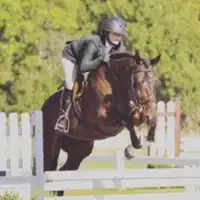 Kate JutagirKate Jutagir is an Equestrian Specialist, Hunter/Jumper Trainer, and the Owner of Blackhound Equestrian, a premier training barn located on 65 acres in Castro Valley, California. Originally designed to be a riding school used as a springboard for dedicated students into careers in the sport, Blackhound Equestrian has grown into a hunter/jumper training program for all levels focusing on providing a solid foundation needed for personal advancement in the sport. Kate has over 25 years of equestrian instruction and training experience. Her focus on developing horse and rider partnerships provides a complete equestrian education for both beginners and advanced riders alike.
Kate JutagirKate Jutagir is an Equestrian Specialist, Hunter/Jumper Trainer, and the Owner of Blackhound Equestrian, a premier training barn located on 65 acres in Castro Valley, California. Originally designed to be a riding school used as a springboard for dedicated students into careers in the sport, Blackhound Equestrian has grown into a hunter/jumper training program for all levels focusing on providing a solid foundation needed for personal advancement in the sport. Kate has over 25 years of equestrian instruction and training experience. Her focus on developing horse and rider partnerships provides a complete equestrian education for both beginners and advanced riders alike.
Equestrian Specialist & Trainer So the best way to keep a horse engaged and calm is to start from the ground up. So before you're even giving commands, you want to set the parameters for your groundwork. That includes working with your horse, moving them with a halter on, leading them, making sure that they understand your body cues, and focusing on what you're asking them to do. Then, as you start working with them, you want to make sure that you take the time at each and every step. Go slow and be super repetitive to get them to understand what you're looking for.
So the best way to keep a horse engaged and calm is to start from the ground up. So before you're even giving commands, you want to set the parameters for your groundwork. That includes working with your horse, moving them with a halter on, leading them, making sure that they understand your body cues, and focusing on what you're asking them to do. Then, as you start working with them, you want to make sure that you take the time at each and every step. Go slow and be super repetitive to get them to understand what you're looking for. -
QuestionWhat's the most important quality I need to train a horse?
 Kate JutagirKate Jutagir is an Equestrian Specialist, Hunter/Jumper Trainer, and the Owner of Blackhound Equestrian, a premier training barn located on 65 acres in Castro Valley, California. Originally designed to be a riding school used as a springboard for dedicated students into careers in the sport, Blackhound Equestrian has grown into a hunter/jumper training program for all levels focusing on providing a solid foundation needed for personal advancement in the sport. Kate has over 25 years of equestrian instruction and training experience. Her focus on developing horse and rider partnerships provides a complete equestrian education for both beginners and advanced riders alike.
Kate JutagirKate Jutagir is an Equestrian Specialist, Hunter/Jumper Trainer, and the Owner of Blackhound Equestrian, a premier training barn located on 65 acres in Castro Valley, California. Originally designed to be a riding school used as a springboard for dedicated students into careers in the sport, Blackhound Equestrian has grown into a hunter/jumper training program for all levels focusing on providing a solid foundation needed for personal advancement in the sport. Kate has over 25 years of equestrian instruction and training experience. Her focus on developing horse and rider partnerships provides a complete equestrian education for both beginners and advanced riders alike.
Equestrian Specialist & Trainer
-
QuestionI have a miniature pony who can't eat treats. How can I reward him?
 Community AnswerConsider rewarding him by releasing pressure. Every time he bends further down, release all pressure off the rope and just scratch his head or neck.
Community AnswerConsider rewarding him by releasing pressure. Every time he bends further down, release all pressure off the rope and just scratch his head or neck.
References
- ↑ Kate Jutagir. Equestrian Specialist & Trainer. Expert Interview. 31 March 2020.
- ↑ http://www.thehorse.com/articles/12159/trick-training-your-horse-to-success
- ↑ http://www.thehorse.com/articles/12159/trick-training-your-horse-to-success
- ↑ http://www.thehorse.com/articles/12159/trick-training-your-horse-to-success
- ↑ http://www.lovehorsebackriding.com/trick-training-your-horse.html
- ↑ http://www.equusite.com/articles/trick/trickBow.shtml
- ↑ http://www.lovehorsebackriding.com/trick-training-your-horse.html
- ↑ http://www.equusite.com/articles/trick/trickBow.shtml
- ↑ http://www.lovehorsebackriding.com/trick-training-your-horse.html
About This Article
To teach a horse to bow, start by standing in front of the horse and offering a treat right below its nose to encourage it to lower its head. Next, incorporate a simple command like "Bow down" before offering the treat. Gradually position the treat lower and lower and remember to consistently use the same command. Eventually, your horse will begin to bend one of its knees in an effort to reach the lowered treat. Be sure to limit training sessions to 5-15 minutes daily for the best results! For tips on choosing a good location for training, read on!
